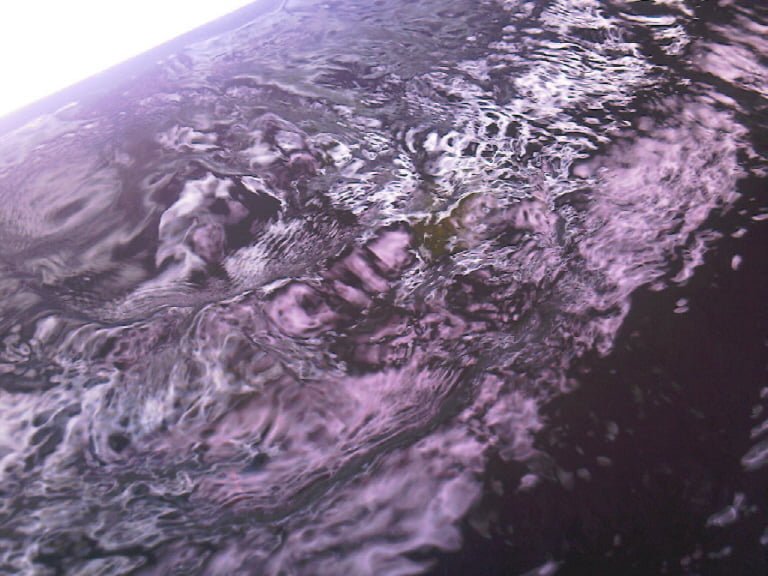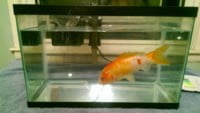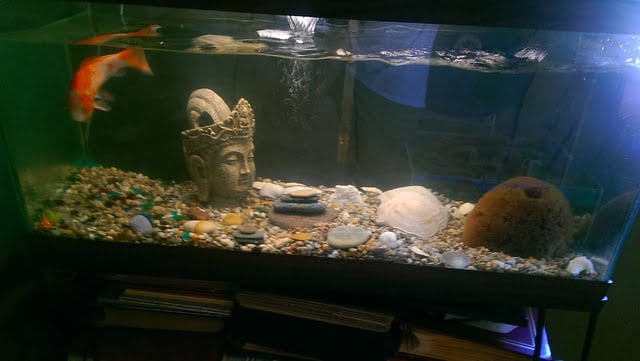Nitrogen cycle explained in depth
STEP 2
Nitrogen cycle explained covers the event from beginning to end. The cycle is vital to the well being of our fish, and if you don’t understand it, your fish are at risk of being poisoned. Goldfish produce a tremendous amount of waste which converts to ammonia in a very short time. Ammonia is extremely toxic to goldfish, but thankfully, beneficial bacteria guard the front lines, soldiers with a cause. Friendly bugs have a voracious appetite for ammonia. The smallest amount of ammonia can quickly poison goldfish. This toxin must be removed by means of a freshwater change and converted with water treatment unless beneficial bacteria are present
Ammonia is the first toxin to convert in the nitrogen cycle
Nitrites, the second toxin to convert in the nitrogen cycle, is also toxic to goldfish. Nitrites are being produced by one type of beneficial bacteria as another type forms to feed on it, converting it into nitrates. Closely related, both toxins are created by living organisms
Healthy fish live in healthy water
Nitrates are the third and final toxin to form in the nitrogen cycle. This toxin can only be removed from the water by means of a partial water change or by using water treatment, however, a thick lining of algae on the side of your tank will also share in the responsibility of removing the gentle giant. Algae forms naturally in a cycled tank or pond, making for an almost perfect ecosystem
Creating a perfect union, the friendly bugs will keep growing in numbers, matching the amount of waste created
-
Beneficial bacteria
The life span of a friendly bacterium is 2 to 4 months, taking 10 ro 12 hours to reproduce. Friendly bugs require ammonia created from waste that contain enzymes as their food source. Only waste produced by living creatures contain enzymes. We refer to this ammonia as ionized
Enzymes the building blocks of life
We think of the nitrogen cycle as being complete when only nitrates are present, but in a natural body of water, little if any nitrates would be measurable. This is because other microorganisms called diatoms appear when nitrates are present, feeding on the so called final toxin in the nitrogen cycle
Nitrogen cycle explained
These diatoms are what we call algae; the living plant. Algae is a very important part of the cycle, feeding on nitrates, reducing levels. Nitrates provide a valuable food source for fish, who then in turn make waste that converts to ammonia, starting the cycle again. The circle of aqua life
Plants absorb Co2 (carbon dioxide) from water freeing it for oxygen to enter, although, the same plant releases Co2 at night. Thankfully, being diurnal, goldfish sleep in the dark of night. It’s a myth that plants produce oxygen
-
What are friendly bugs?
There are two kinds of bacteria in a goldfish tank or pond; the beneficial and the harmful. Bad bugs are everywhere just waiting for an opportunity to multiply. Good bugs have much better manners; waiting for an invitation. Where you find large colonies of beneficial or what we call friendly bacteria, you’ll find very few of the unfriendly. This is because the two require very different water conditions
Nitrogen cycle explained
Goldfish and beneficial bacteria alike require cool water that is rich in minerals and heavily oxygenated. Harmful bacteria cannot tolerate oxygen, preferring stagnant water which contains low levels. Bad bugs thrive in warmer water temperature, so we can assume they will build their colonies beneath thick layers of gravel or under plants and decorations
Goldfish and good bacteria alike become dormant in cold water
Be consistent with water changes and gravel vacuuming. Removing too much waste one week, and too little the next could break or interrupt the cycle. Overfeeding one day and underfeeding the next could lead to a spike in the nitrogen cycle as does adding a new fish or a rotting plant. It’s important to feed several small meals daily opposed to feeding one or two large ones. First and foremost, goldfish don’t have stomachs, and digest their food in a mater of hours. The waste in their tract needs to be forever present so that the swim bladder organ has Co2 to function; the two being connected. Another reason to feed less more often; beneficial bacteria are extremely delicate and need food consistently. Irregular feeding leads to spikes in the cycle
Establishing a Pond Pump
If nitrates are still high after regular water changes test tap water for the toxin. If tap is free of nitrates, feed less and or remove more waste to lower amounts. Feed small meals throughout the day. Feed more vegetables and less food high in protein. This habit not only encourages the consistent production of nitrates, making for a stronger colony of beneficial bacteria, but it is much better for the sensitive digestive system of a goldfish
Levels of nitrates are based solely on the amount of waste present in an environment
The greater the amount of fish compared to the body of water, the more concentrated the amount of waste being produced, and vice versa
Nitrogen cycle explained
The air we breathe is made up of gases. Nitrogen, critical for life is at the top of list with oxygen coming in as a close second. Out of the ten gases in our atmosphere, argon, carbon dioxide, neon, helium, methane, krypton, hydrogen and xenon complete the list. Our goldfish give much more than we ever imagined, improving the quality of the air in our homes

The aquarium in the photo below is much to small for this fish. It has no room to swim; no gravel to peck through. If you look closely you’ll see tiny bubbles (supersaturated gases) forming in the glass. The goldfish owner was performing 100% water changes. Due to bad bacteria forming in an unhealthy environment the fish is in poor health

Here is the same fish in a larger aquarium with healthy water after it’s keeper was educated. The sea sponge is covering a pond pump, and acting as a filter. This is one happy fish

STEP 3: Gravel Vacuum Substrate
Learn about the only safe method of cycling a live fish house SEMI Live Fish Free Cycle
About Ammonia
10 Steps to Goldfish Koi Keeping
copyright 2007
Author: Brenda Rand